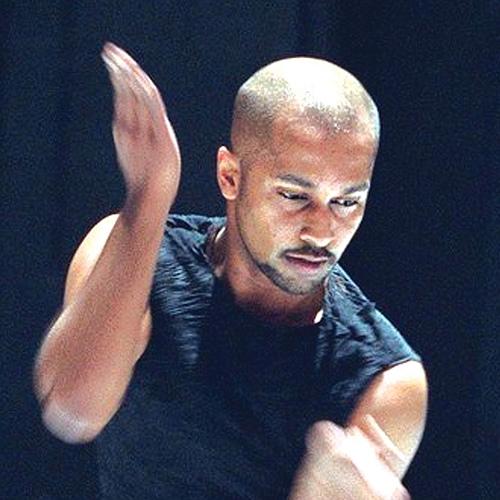What do you call a dancer with a fractured shoulder and only half a show to offer, who nevertheless takes you to the outer reaches of dance nirvana? It can only be Akram Khan. Now fêted as a (reasonable) contemporary choreographer, the favourite of Kylie, Juliette Binoche, Sylvie Guillem, Khan is too little celebrated for what he does at a level beyond anything most of us are ever likely to see, which is dancing in his magnificent, complex, disturbing traditional Indian form of Kathak.
Four weeks ago he was intending to prepare for Sadler’s Wells a new contemporary dance premiere, Gnosis, to launch its imaginative festival of dance and music last night, which he and Nitin Sawhney are curating. Gnosis would be the second half of an evening in which he would display his Kathak credentials: the old and new sides of him. But a left shoulder fracture put paid to that, and only a week ago he was still in a sling.
Despite having to cancel the premiere, still the man danced Kathak like a god, humbly determined to serve his packed house. The hastily edited show was billed to last only an hour, but in the event he gave us almost half as much again (and I hate to think how that shoulder was feeling).
The thing about Akram in Kathak is that there is no point at which you can say “this is music, and that is dance” - his ears and feet are intricately linked to produce syncopational delights with slapping bare soles and heels, his arms and eyes switch through unbelievable directional changes at lightning speed almost like a dog chasing its tail, his vocalising seems inextricable from an urge to move that wells up from deep in his body. His first solo was 15 minutes long, at least - a feat of stamina alone equivalent to running several miles, and filled with extremes of silken soft undulations and dagger-sharp, glinting jags and jabs, with dazzling spins and helter-skelter rushes across the stage that evoke thoughts of lovers, knights, dashing poets.
It began with whispering ankle bells in the dark, as a fine girl Japanese drummer showed every colour of percussive dynamic possible with two sticks on two skins, from a barely audible shiver to an explosive fortissimo roll. Khan appeared, his shaven head gleaming, a monkish figure in olive-grey tunic, with thick anklets of bells. With one raise of an arm and a very slight inhalation through his entire body, he commanded the stage - it’s that instinctive in-breath, which reveals his own anticipation and moment of self-dedication, that gives the thrill. A kind of obeisance to his art, I think, which you feel with only the very few, very great artists.
That magnificent solo, Polaroid Feet, was choreographed and (tellingly) composed in 2001 by Gauri Sharma Tripathi, a regular supplier to Khan of traditional Kathak material for his unique fusion of musical dance. In his improvisation later, one was more conscious of being shown simple building blocks and a slow gathering of rhythmic like-mindedness with his musicians, as he vocalised patterns at a microphone that they picked up on their percussion, or smacked his feet faster to whip them along. Once he’d set a pace, off he’d dart in an improvisation, like showing virtuosic studies for technique - a whirl of unbelievable pirouettes, or long tender undulations like a breeze through a wheat field.
Akram's drummers are mathematicians, and they like nothing better than being thrown a skein of numbers to calculate rhythmic possibilities
The music-making was also fascinating. As Akram said, his drummers are mathematicians, and they like nothing better than being thrown a skein of numbers to calculate rhythmic possibilities with their fingers and sticks. The taiko girl, Yoshie Sunahata, featured in an immaculately exciting trio with Sanju Sahai on tabla and Manjunath B Chandramouli on mridanga. Another musical interlude seemed to be composed of only five descending notes, and yet the continual changes in pulse, Faheem Mazar’s lamenting voice, the detailed variety in Soumik Datta’s plucking of his sarod strings, the cornucopia of tabla timbres, all this turned a restrained theme into a highly varied journey of mood. (Note to Sadler’s Wells: why can’t we have surtitles for Kathak song, which like flamenco is a soulfully literate lyrical form?)
Then a surprise: Akram declared that if he couldn’t perform his new piece, he could at least do an abridged arrangement of the final scene, where the blind princess Gandhari dies. We were in for a shock. While Sunahata sang with eloquent sadness alongside him, Khan turned all that stupendous articulation and control of his, which we had just seen so dazzlingly transfigured into light, fluidity and momentum, into a fearful visualisation in dance of the slow breakdown of all that into quivers, jitters and gibbers, a blur of disintegration that came to a sudden stop, as if the instant when spirit left matter. It felt like watching death. The full work is now to be premiered next spring at Sadler’s Wells.
- Akram Khan joins Nitin Sawhney for a music-dance premiere Confluence at Sadler's Wells, 26-28 November; the Svapnagata festival, until 28 November, includes performances by musicians and dancers. Book online here
- Check out what's on at Sadler's Wells this season














Add comment